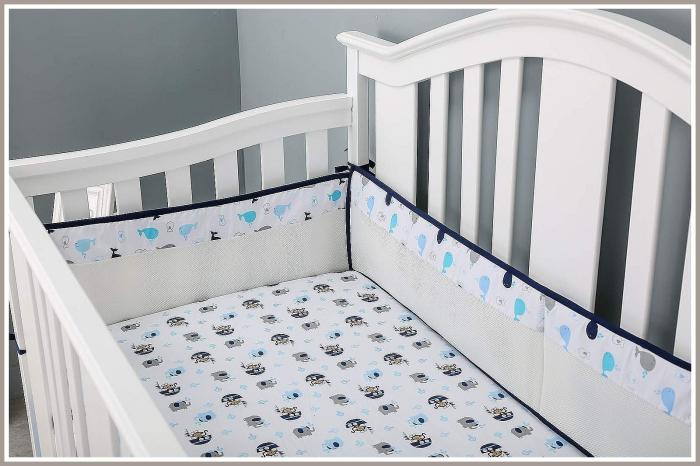Mesh crib liners have become a popular choice among parents looking to enhance their baby’s sleep environment. They are designed to protect infants from bumping their heads against crib rails and to reduce the risk of entrapment. However, their safety has been a topic of concern and debate. In this article, we will explore the safety aspects of mesh crib liners, their benefits, potential risks, and guidelines for their use.
What Are Mesh Crib Liners?
Mesh crib liners are breathable barriers that are installed between the crib rails and the mattress. They are made from mesh fabric, which allows air to flow freely while providing a soft barrier for the baby. The primary purpose of these liners is to prevent the baby from getting arms or legs stuck between the crib slats and to avoid head injuries from bumping against the rails.
How They Work
Mesh crib liners are designed to cover the interior sides of the crib. They are typically secured with ties or Velcro straps. The mesh material is intended to be breathable, allowing air to circulate around the baby. This design aims to reduce the risk of suffocation and overheating while protecting the baby from sharp edges and gaps.
Safety Concerns with Mesh Crib Liners
While mesh crib liners are marketed as a safer alternative to padded crib bumpers, they still come with safety concerns that parents should consider.
1. Risk of Entrapment
Even though mesh liners are designed to be breathable, there is still a risk of entrapment. Babies can sometimes get their limbs or heads caught in the mesh or between the mesh and the crib slats. Although this risk is lower compared to padded bumpers, it is not entirely eliminated.
2. Breathing Obstruction
There have been concerns that the mesh material itself could potentially obstruct a baby’s breathing if it becomes dislodged or if the baby presses against it. The mesh is meant to be breathable, but it’s crucial to ensure that it remains securely attached and does not sag or shift.
3. Sudden Infant Death Syndrome (SIDS)
The American Academy of Pediatrics (AAP) does not recommend using any type of crib bumper, including mesh liners, due to the association with an increased risk of SIDS. They advise that the safest sleep environment for infants is a firm mattress with no additional padding, pillows, or blankets.
Benefits of Mesh Crib Liners
Despite the safety concerns, mesh crib liners do offer some potential benefits, which may appeal to parents seeking to protect their baby’s crib environment.
1. Breathable Material
One of the key advantages of mesh crib liners is their breathability. The mesh fabric allows for air circulation, reducing the risk of overheating and suffocation compared to padded bumpers.
2. Prevents Limb Entrapment
Mesh liners can help prevent babies from getting their arms or legs stuck between crib slats. This can reduce the risk of minor injuries and discomfort.
3. Soft Barrier
Mesh crib liners provide a soft barrier between the baby and the crib rails. This can help prevent head injuries from bumping against the hard surfaces of the crib.
Guidelines for Safe Use
If you choose to use a mesh crib liner, it is important to follow specific guidelines to ensure safety:
1. Follow Manufacturer Instructions
Always adhere to the manufacturer’s instructions for installation and use. Ensure that the liner is securely attached and does not have any loose or dangling parts that could pose a risk.
2. Regular Inspection
Regularly check the mesh liner for any signs of wear or damage. Replace the liner if it becomes torn, loose, or otherwise compromised.
3. Avoid Overcrowding
Ensure that the crib is not overcrowded with other items, such as blankets, pillows, or stuffed animals. The AAP recommends keeping the sleep area as clear as possible to reduce the risk of suffocation and SIDS.
4. Secure Installation
Make sure the mesh liner is installed securely and does not shift or sag. It should fit snugly against the crib slats without creating gaps where the baby could become entangled.
5. Consider Alternatives
Evaluate other safety measures for your baby’s crib, such as ensuring that the crib meets current safety standards and that the mattress fits snugly without gaps. You might also consider using a sleep sack or wearable blanket to keep your baby warm without adding loose bedding.
See also: Are Microwave Steam Sterilizers Safe
Conclusion
Mesh crib liners are designed to provide a breathable barrier and prevent some common crib injuries. However, they come with their own set of safety concerns and are not universally recommended. The primary safety guidelines from organizations like the American Academy of Pediatrics suggest keeping the crib environment as simple and free of extra padding as possible.
If you decide to use a mesh crib liner, it is essential to follow all safety guidelines, regularly inspect the liner for damage, and consider alternative methods for ensuring a safe sleep environment for your baby. Always prioritize the advice of your pediatrician and current safety recommendations to create the safest possible sleeping conditions for your infant.


